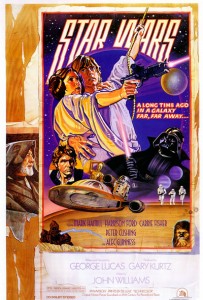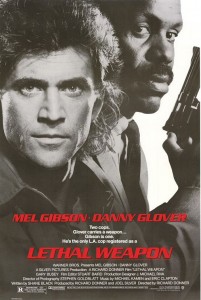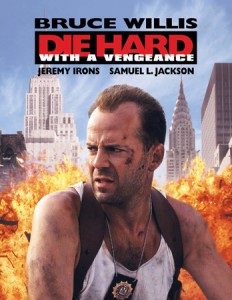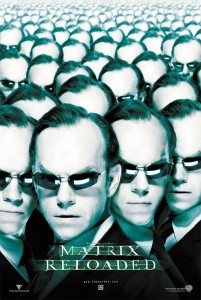There is no specific term for a film franchise that is directly undermined by later installments of itself, but there should be. If there are so many trilogies out there that have crippled themselves by simply not walking away while the getting was good, there ought to be a name for the phenomenon. I nominate: Killogies.
A Killogy is, part-and-parcel, a product of diminishing returns, and except for only the most committed of fanboys, is easily dissected, one film from another, so that the offending bits can be ignored. Before we delve into what doesn’t work, it’s important to understand what does, and I have three examples to illustrate this.
 The best way to make a trilogy is to have a full grasp of a three-picture, three-act story mapped out. Peter Jackson knew the best way to adapt the three books of The Lord of the Rings was to do them all concurrently. It is murder on a film crew to commit to five or more years of an individual’s life to a single storyline, but that continuity is crucial in making an actual, honest-to-God trilogy. Small details, from an actor’s weight and physical aging, to bigger ones like being contractually denied to rejoin, can be micromanaged in this manner, whereas if a crew breaks from one film to the next, a director is at the mercy of the forces their actors were subjected to on someone else’s set.
The best way to make a trilogy is to have a full grasp of a three-picture, three-act story mapped out. Peter Jackson knew the best way to adapt the three books of The Lord of the Rings was to do them all concurrently. It is murder on a film crew to commit to five or more years of an individual’s life to a single storyline, but that continuity is crucial in making an actual, honest-to-God trilogy. Small details, from an actor’s weight and physical aging, to bigger ones like being contractually denied to rejoin, can be micromanaged in this manner, whereas if a crew breaks from one film to the next, a director is at the mercy of the forces their actors were subjected to on someone else’s set.
Robert Zemeckis had an understanding of this when he shot Back To The Future 2 and 3 back-to-back. Neither film has the buoyancy of the first, still one of the all-time great popcorn flicks, and one of the best films under Steven Spielberg’s production aegis, Amblin Entertainment. At the same time, when accepted on their own terms, 2 & 3 are still entertaining and, at the core, remain true to the characters established in the first film, which is a difficult task. As is the case most often with trilogies, they were never meant to be so. When #1 ended with the card, “To be continued,” that was half a joke and half wishful thinking. The further adventures of Marty McFly had to be quickly assembled in the wake of BttF‘s success.
The king of the liar-liars is, doubtlessly, George Lucas who had his action-figure-hoarding minions thoroughly convinced he had the Star Wars saga mapped from the beginning. While threads of The Empire Strikes Back may have originated in what we now know as A New Hope, that film was written and constructed to stand alone as a space opera swashbuckler, not entirely as a sci-fi homage to Asian cinema. But even if Lucas fudged the facts a little, he made a wise decision to hire on Lawrence Kasdan to write the Empire screenplay. His ability to blend the speed-blur action of the first film with the darker, more heavy bag of plot requirements, while still keeping the characters in character, pulls the hardest stunt off – making a sequel equal to the original, and in some ways even better. Even if Return of the Jedi is a step backward (in the eyes of some an unforgivable step), it still is a fun ride and, ultimately, an enjoyable conclusion. Whether the creation of the Ewoks was less a story necessity than a merchandising campaign run amok is a fan convention debate left for another time.
But what about the Killogy, the series so hampered by latter installments that they never could survive? Here are some examples.
 Lethal Weapon – Richard Donner’s first installment was a brisk summer actioner finding Danny Glover and a pre-rant Mel Gibson chasing after, and surviving, crazy bad guys and crazier good guys. By adding Joe Pesci to the mix for Lethal Weapon 2, the ability to wedge a little more comedy in raised the stakes. I would argue the second film is a lot stronger than the first for including the spastic but endearing character of Leo Getz. It also helps that the script was lifted out of the buddy cop trenches via writer Jeffrey Boam (Indiana Jones and the Last Crusade, Innerspace).
Lethal Weapon – Richard Donner’s first installment was a brisk summer actioner finding Danny Glover and a pre-rant Mel Gibson chasing after, and surviving, crazy bad guys and crazier good guys. By adding Joe Pesci to the mix for Lethal Weapon 2, the ability to wedge a little more comedy in raised the stakes. I would argue the second film is a lot stronger than the first for including the spastic but endearing character of Leo Getz. It also helps that the script was lifted out of the buddy cop trenches via writer Jeffrey Boam (Indiana Jones and the Last Crusade, Innerspace).
The problem is that the additions never stopped. Rene Russo was wedged in for part 3, despite a glaring lack of chemistry between her and Mel Gibson, in my opinion. So now you had two peripheral characters fighting for screen time, Pesci’s Getz and Russo’s supercop Lorna Cole. So what do you do when there are too many cooks in the kitchen? That’s right, shove in another cook. Here comes Chris Rock as Detective Lee Butters for Lethal Weapon 4, and by the time the poor advertising department of Warner Brothers got the memo, they had six faces to cram into their two-buddy-cop posters (not forgetting Jet Li as Wah Sing Ku). The more characters that were introduced, the less time there was to focus on what made the first two films memorable, being that relationship between Glover’s Murtagh and Gibson’s Riggs.
There had been, up until OksanaGate, speculation of trying to pull together a Lethal Weapon 5, but there ain’t enough money in Hollywood to insure that many stars, and no Ginsu knife sharp enough to cut a plot so thin as to accommodate them all.
 Die Hard – A crucial error in building a franchise is to stray too far from what made the first installment great. Another crucial error is to hew too close to it. Die Hard is one of the all-time great action films and Bruce Willis’ John McClane one of the genre’s best characters, endearing, likable, flawed and most certainly not a superhero. He also has a bad luck streak.
Die Hard – A crucial error in building a franchise is to stray too far from what made the first installment great. Another crucial error is to hew too close to it. Die Hard is one of the all-time great action films and Bruce Willis’ John McClane one of the genre’s best characters, endearing, likable, flawed and most certainly not a superhero. He also has a bad luck streak.
That is not a proper basis for writing a sequel though, and yet here we are in Die Hard 2 with McClane and his wife yet again in jeopardy at Christmastime dealing with officious boneheads, ruthless villains that aren’t as they seem, and plot points so rigidly recast from the original, only a DNA test could tell them apart, excepting that the second is nowhere near the breeze the first was. By the time Die Hard With A Vengeance arrived, the fun quotient was replaced by breathless stunt pieces, McClane was completely estranged from his wife, unlikable, and now found bickering with Samuel L. Jackson’s Zeus. All the racial friction the better Lethal Weapon entries side-stepped or worked out were splattered all over the place here. It’s still better than number 2, but considering what we also call number 2, that’s not saying a whole lot.
Many, many years later, Live Free Or Die Hard arrived, rejecting massive chunks of the McClane attraction in favor of making him more superheroic, instead of crawling through building ductwork, he’s outrunning fighter jets in semis, all the while being saddled with a kvetchy sidekick, like he actually needed yet another sidekick. I’m not saying the original Die Hard was the model of plausibility, but at this late juncture, all involved seemed to say, “Stuff it in and let the audience figure it out later.” Willis is all-in for a possible fifth turn as McClane. I’m not so sure myself.
 The final Killogy is the daddy of them all, a movie franchise that redefined shattered expectations; it is none other than The Matrix. The original film set the world on its collective ear, introducing imagery that truly stunned, but went one better with a story that tapped into deep wells of human existence. Everyone has felt, at one point or another, that their life wasn’t quite right, something was way off kilter in a manufactured manner, and coincidence often arrives much too coincidentally. The brothers Wachowski constructed a fable that explained these unexplainable tics of merely being, entering this world via Neo (Keanu Reeves), a computer hacker waking up to the reality that his own is a computer fiction.
The final Killogy is the daddy of them all, a movie franchise that redefined shattered expectations; it is none other than The Matrix. The original film set the world on its collective ear, introducing imagery that truly stunned, but went one better with a story that tapped into deep wells of human existence. Everyone has felt, at one point or another, that their life wasn’t quite right, something was way off kilter in a manufactured manner, and coincidence often arrives much too coincidentally. The brothers Wachowski constructed a fable that explained these unexplainable tics of merely being, entering this world via Neo (Keanu Reeves), a computer hacker waking up to the reality that his own is a computer fiction.
The media picked up on the surface attributes of the movie and we were besieged with instance after instance of “bullet time” effects in everything from parodies to music videos to commercials. Yet what made the movie work was how it struck a chord with something deeply psychological and personal to each and every viewer. It was something shared but unexplainable, like a falling dream that wakes you in your bed with a jolt, only an explanation was now being constructed.
What wasn’t being constructed at that time was a Parts Two And Three, so much like George Lucas and Star Wars, it was time to go deeper, not because the story demanded it but because the studio did. What we end up with is yet another techno-war with ragtag rebels fighting an advanced foe. It worked for Luke Skywalker, it worked for John Connor and, damn it, it was going to work for Neo. Wishing won’t make it so though, and the farther we slipped down the rabbit hole, into “the real world,” the less there was for the audience to connect to. We were alien to this stuff and awash in neo-messianic gobbledygook, pun intended.
The Wachowskis got the back-to-back filming part right, but they went into it forgetting what really fascinated people about their first foray into The Matrix and, unwittingly, wrote the textbook for what not to do with a franchise.
There are plenty more Killogies out there, from The Terminator, to the Alien films, to even the Austin Powers films if you want to stretch your scope out farther. What are film series that you feel irrevocably jumped the rails?




Comments